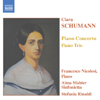Schumann, C Piano Concerto in A minor, Op 7; Piano Trio in G minor, Op 17
That temptation to show off in Clara’s concerto is thankfully resisted here
View record and artist detailsRecord and Artist Details
Composer or Director: Clara (Josephine) Schumann
Label: Naxos
Magazine Review Date: 6/2005
Media Format: CD or Download
Media Runtime: 54
Mastering:
Stereo
DDD
Catalogue Number: 8 557552

Tracks:
| Composition | Artist Credit |
|---|---|
| Concerto for Piano and Orchestra |
Clara (Josephine) Schumann, Composer
Alma Mahler Sinfonietta Clara (Josephine) Schumann, Composer Francesco Nicolosi, Piano Stefania Rinaldi, Conductor |
| Piano Trio |
Clara (Josephine) Schumann, Composer
Andrea Noferini, Cello Clara (Josephine) Schumann, Composer Francesco Nicolosi, Piano Rodolfo Bonucci, Violin |
Author: Nalen Anthoni
The autograph manuscript of Robert Schumann’s Piano Concerto (1845) revealed not only the toil but also the hand of Clara, particularly in the last movement. Eleven years earlier, Robert had orchestrated a Concertsatz by the 14-year-old Clara and this became the corresponding movement of her concerto which she soon completed on her own.
The Concertsatz is as long as the other movements put together and a shorter finale might have been beneficial. Yet the complete, though imperfect, work is a notable achievement for so young a composer; and the piano part could be seen as a vehicle for virtuosity. All credit therefore to Francesco Nicolosi for not succumbing to temptation. His playing is deep-toned and tractable and, in conjunction with Stefania Rinaldi who eschews strident orchestral attack, finds a vein of melancholy in the music. He also ably balances the implied duality of the Romanze in which the marking con grazia conflicts somewhat with the additional La melodia ben marcato e legato.
‘Not a gifted melodist but skilful handling of other elements compensates’ is one of biographer Nancy B Reich’s verdicts on Clara Schumann. And an element is the assured way modulations are treated in the Piano Trio (1846). Nicolosi adapts his playing to the demands of the genre, and he interacts sympathetically with his fine partners. Perhaps the Scherzo (to be played Tempo di menuetto) ought to have been bucolic rather than gracious but this doesn’t detract from a very communicative performance. The orchestra’s cellos and basses are lightweight and the solo violin occasionally squeaky but the sound is otherwise good.
The Concertsatz is as long as the other movements put together and a shorter finale might have been beneficial. Yet the complete, though imperfect, work is a notable achievement for so young a composer; and the piano part could be seen as a vehicle for virtuosity. All credit therefore to Francesco Nicolosi for not succumbing to temptation. His playing is deep-toned and tractable and, in conjunction with Stefania Rinaldi who eschews strident orchestral attack, finds a vein of melancholy in the music. He also ably balances the implied duality of the Romanze in which the marking con grazia conflicts somewhat with the additional La melodia ben marcato e legato.
‘Not a gifted melodist but skilful handling of other elements compensates’ is one of biographer Nancy B Reich’s verdicts on Clara Schumann. And an element is the assured way modulations are treated in the Piano Trio (1846). Nicolosi adapts his playing to the demands of the genre, and he interacts sympathetically with his fine partners. Perhaps the Scherzo (to be played Tempo di menuetto) ought to have been bucolic rather than gracious but this doesn’t detract from a very communicative performance. The orchestra’s cellos and basses are lightweight and the solo violin occasionally squeaky but the sound is otherwise good.
Discover the world's largest classical music catalogue with Presto Music.

Gramophone Digital Club
- Digital Edition
- Digital Archive
- Reviews Database
- Full website access
From £8.75 / month
Subscribe
Gramophone Full Club
- Print Edition
- Digital Edition
- Digital Archive
- Reviews Database
- Full website access
From £11.00 / month
Subscribe
If you are a library, university or other organisation that would be interested in an institutional subscription to Gramophone please click here for further information.




